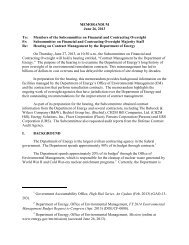NSSN Virginia Class Attack Submarine
NSSN Virginia Class Attack Submarine
NSSN Virginia Class Attack Submarine
You also want an ePaper? Increase the reach of your titles
YUMPU automatically turns print PDFs into web optimized ePapers that Google loves.
<strong>NSSN</strong> <strong>Virginia</strong> <strong>Class</strong> <strong>Attack</strong> <strong>Submarine</strong>http://www.naval-technology.com/projects/nssn/The <strong>Virginia</strong> <strong>Class</strong> new attack submarine is an advanced stealth multi-mission nuclear-poweredsubmarine for deep ocean anti-submarine warfare and littoral (shallow water) operations.Although the Seawolf submarine was developed to provide an eventual replacement for the USNavy Los Angeles <strong>Class</strong> submarines in combating the Soviet forces, the prohibitive unit cost andchanging strategic requirements led to the US Navy defining a smaller new-generation attacksubmarine.The Electric Boat division of General Dynamics, Connecticut is the lead design authority for the<strong>Virginia</strong> <strong>Class</strong>. General Dynamics Electric Boat has built the first of class – <strong>Virginia</strong> (SSN 774)and Northrop Grumman Newport News the second – Texas (SSN 775).The subsequent vessels will be: Hawaii (SSN 776), New Hampshire (SSN 778), Missouri (SSN780), Mississippi (SSN 782) and John Warner (SSN 785) being built by Electric Boat, and NorthCarolina (SSN 777), New Mexico (779), California (SSN 781), Minnesota (SSN 783) and NorthDakota (SSN 784) being built by Newport News.The US Navy's total requirement is for 30 of the class. It placed a bulk-buy contract for the firstfive ships and, in January 2004, placed a multi-year contract for the following five. In December2008, the navy signed a $14bn contract with General Dynamics and Northrop Grumman foreight more submarines.<strong>Virginia</strong> was laid down in September 1999, launched in August 2003 and commissioned inOctober 2004. It underwent a three-year operational evaluation before operational deployment.Texas was launched in April 2005, delivered in June 2006 and commissioned in September2006. The keel for Hawaii was laid in August 2004, it was launched in June 2006 andcommissioned in May 2007.North Carolina was launched in May 2007, delivered in December 2007, and commissioned inMay 2008. New Hampshire was launched in February 2008 and commissioned in October 2008.The keel for New Mexico was laid in April 2008.It was launched in December 2008 and commissioned in March 2010. Missouri (SSN 780) beganconstruction in December 2004. Her keel was laid in September 2008, launched in November2009 and commissioned in July 2010. The keel for California (SSN-781) was laid in May 2010.DesignThe engineering teams and the design and build teams at Electric Boat in partnership with theNaval Sea Systems Command, NAVSEA, of the US Navy have used extensive CAD/CAEsimulation systems to optimise the design of the submarine. The hull size is length 377ft by
eam 34ft and the displacement is 7,300t dived, which is smaller than the more expensiveSeawolf attack submarine with displacement 9,137t dived.The hull structure contains structurally integrated enclosures, which accommodate standard 19inand 24in width equipment for ease of installation, repair and upgrade of the submarine's systems."The US Navy's total requirement is for 30 of the class."The submarine is fitted with modular isolated deck structures, for example the submarine'scommand centre will be installed as one single unit resting on cushioned mounting points. Thesubmarine's control suite is equipped with computer touch screens.The submarine's steering and diving control is via a four-button, two-axis joystick.The noise level of the <strong>Virginia</strong> is equal to that of the US Navy Seawolf, SSN 21, with a loweracoustic signature than the Russian Improved Akula <strong>Class</strong> and fourth-generation attacksubmarines. To achieve this low acoustic signature, the <strong>Virginia</strong> incorporates newly designedanechoic coatings, isolated deck structures and a new design of propulsor.Goodrich is supplying high-frequency sail array acoustic windows and composite sonar domes.Command systemThe command and control systems module (CCSM) has been developed by a team led byLockheed Martin Naval Electronics & Surveillance Systems – Undersea Systems (NE&SS-US)of Manassas, <strong>Virginia</strong>. It will integrate all of the vessel's systems – sensors, countermeasures,navigation, weapon control, and will be based on open system architecture (OSA) with Q-70colour common display consoles.Weapon control is provided by Raytheon with a derivative of the CCS mk2 combat system, theAN/BYG-1 combat control system, which is also being fitted to the Australian Collins <strong>Class</strong>submarines.The <strong>Virginia</strong> has two mast-mounted Raytheon submarine high data rate (sub HDR) multi-bandsatellite communications systems that allow simultaneous communication at super highfrequency (SHF) and extremely high frequency (EHF)."The submarine is equipped with 12 vertical missile launch tubes and four 533mm torpedotubes."Weapon systemThe submarine is equipped with 12 vertical missile launch tubes and four 533mm torpedo tubes.The vertical launching system has the capacity to launch 16 Tomahawk submarine-launchedcruise missiles (SLCM) in a single salvo. There is capacity for up to 26 mk48 ADCAP mod 6
heavyweight torpedoes and sub harpoon anti-ship missiles to be fired from the 21in torpedotubes. Mk60 CAPTOR mines may also be fitted.An integral lock-out / lock-in chamber is incorporated into the hull for special operations. Thechamber can host a mini-submarine, such as Northrop Grumman's Oceanic and Naval Systemsadvanced SEAL delivery system (ASDS), to deliver special warfare forces such as navy sea airland (SEAL) teams or Marine reconnaissance units for counter-terrorism or localised conflictoperations.Countermeasures<strong>Virginia</strong> is fitted with the AN/WLY-1 acoustic countermeasures system being developed byNorthrop Grumman, which provides range and bearing data, and the mast-mounted AN/BLQ-10electronic support measures (ESM) system from Lockheed Martin Integrated Systems.AN/BLQ-10 provides full spectrum radar processing, automatic threat warning and situationassessment.SensorsThe <strong>Virginia</strong> <strong>Class</strong> sonar suite includes bow-mounted active and passive array, wide aperturepassive array on flank, high-frequency active arrays on keel and fin, TB 16 towed array and theLockheed Martin TB-29A thinline towed array, with the AN/BQQ-10(V4) sonar processingsystem. A Sperry Marine AN/BPS-16(V)4 navigation radar, operating at I-band, is fitted.The submarines have two Kollmorgen AN/BVS-1 photonic masts, rather than optical periscopes.Sensors mounted on the non-hull-penetrating photonic mast include LLTV (low-light TV),thermal imager and laser rangefinder. The mast is the Universal Modular Mast developed byKollmorgen and its Italian subsidiary, Calzoni."The submarines have two Kollmorgen AN/BVS-1 photonic masts, rather than opticalperiscopes."The Boeing LMRS long-term mine reconnaissance system will be deployed on the <strong>Virginia</strong><strong>Class</strong>. LMRS includes two 6m autonomous unmanned underwater vehicles, an 18m roboticrecovery arm and support electronics.Northrop Grumman Electronic Systems is supplying the lightweight, wide-aperture array(LWWAA) system based on fibre-optic arrays, instead of traditional ceramic hydrophonesensors.LWWAA is a passive ASW sonar system which consists of three large array panels mounted oneither side of the submarine's hull.Lockheed Martin will provide acoustic rapid commercial off-the-shelf insertion (A-RCI)hardware for the sonar system upgrade. The $25.1m contract was awarded in August 2009.
PropulsionThe main propulsion units are the GE pressure water reactor S9G, designed to last as long thesubmarine, two turbine engines with one shaft and a United Defense pump jet propulser,providing 29.84MW. The speed is over 25kt dived.






